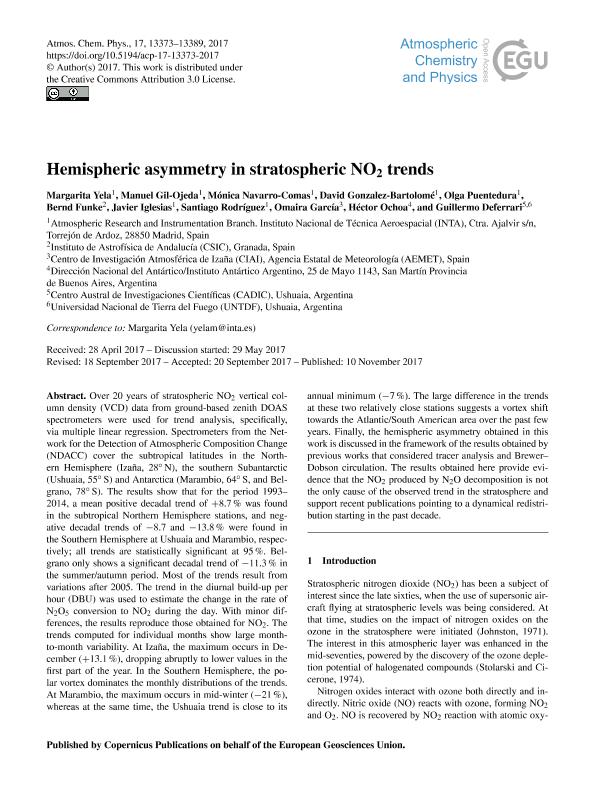Artículo
Hemispheric asymmetry in stratospheric NO2 trends
Yela, Margarita; Gil-Ojeda, Manuel; Navarro-Comas, Mónica; Gonzalez-Bartolomé, David; Puentedura, Olga; Funke, Bernd; Iglesias, Javier; Rodríguez, Santiago; García, Omaira; Ochoa, Héctor; Deferrari, Guillermo Alejandro

Fecha de publicación:
11/2017
Editorial:
Copernicus Publications
Revista:
Atmospheric Chemistry and Physics
ISSN:
1680-7316
e-ISSN:
1680-7324
Idioma:
Inglés
Tipo de recurso:
Artículo publicado
Clasificación temática:
Resumen
Over 20 years of stratospheric NO2 vertical column density (VCD) data from ground-based zenith DOAS spectrometers were used for trend analysis, specifically, via multiple linear regression. Spectrometers from the Network for the Detection of Atmospheric Composition Change (NDACC) cover the subtropical latitudes in the Northern Hemisphere (Izaña, 28° N), the southern Subantarctic (Ushuaia, 55° S) and Antarctica (Marambio, 64° S, and Belgrano, 78° S). The results show that for the period 1993-2014, a mean positive decadal trend of +8.7 % was found in the subtropical Northern Hemisphere stations, and negative decadal trends of-8.7 and-13.8 % were found in the Southern Hemisphere at Ushuaia and Marambio, respectively; all trends are statistically significant at 95 %. Belgrano only shows a significant decadal trend of-11.3 % in the summer/autumn period. Most of the trends result from variations after 2005. The trend in the diurnal build-up per hour (DBU) was used to estimate the change in the rate of N2O5 conversion to NO2 during the day. With minor differences, the results reproduce those obtained for NO2. The trends computed for individual months show large month-to-month variability. At Izaña, the maximum occurs in December (+13.1 %), dropping abruptly to lower values in the first part of the year. In the Southern Hemisphere, the polar vortex dominates the monthly distributions of the trends. At Marambio, the maximum occurs in mid-winter (-21 %), whereas at the same time, the Ushuaia trend is close to its annual minimum (-7 %). The large difference in the trends at these two relatively close stations suggests a vortex shift towards the Atlantic/South American area over the past few years. Finally, the hemispheric asymmetry obtained in this work is discussed in the framework of the results obtained by previous works that considered tracer analysis and Brewer-Dobson circulation. The results obtained here provide evidence that the NO2 produced by N2O decomposition is not the only cause of the observed trend in the stratosphere and support recent publications pointing to a dynamical redistribution starting in the past decade.
Palabras clave:
Atmosfera
,
Stratospheric
,
No2
,
Trends
Archivos asociados
Licencia
Identificadores
Colecciones
Articulos(CADIC)
Articulos de CENTRO AUSTRAL DE INVESTIGACIONES CIENTIFICAS
Articulos de CENTRO AUSTRAL DE INVESTIGACIONES CIENTIFICAS
Citación
Yela, Margarita; Gil-Ojeda, Manuel; Navarro-Comas, Mónica; Gonzalez-Bartolomé, David; Puentedura, Olga; et al.; Hemispheric asymmetry in stratospheric NO2 trends; Copernicus Publications; Atmospheric Chemistry and Physics; 17; 21; 11-2017; 13373-13389
Compartir
Altmétricas



